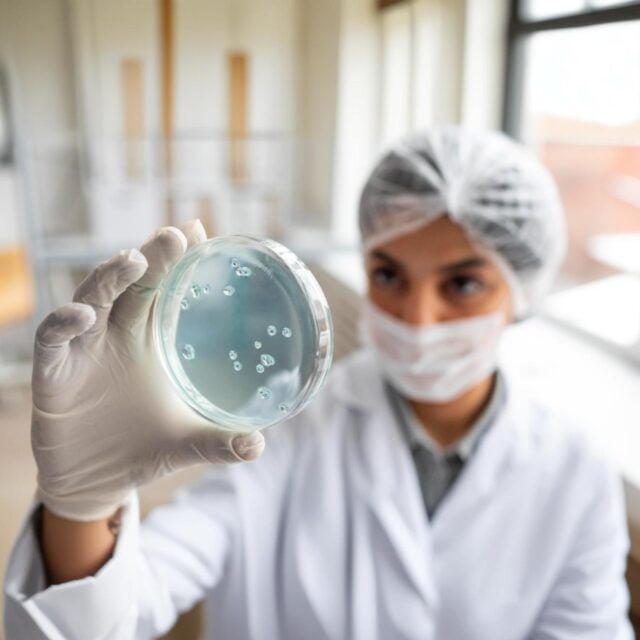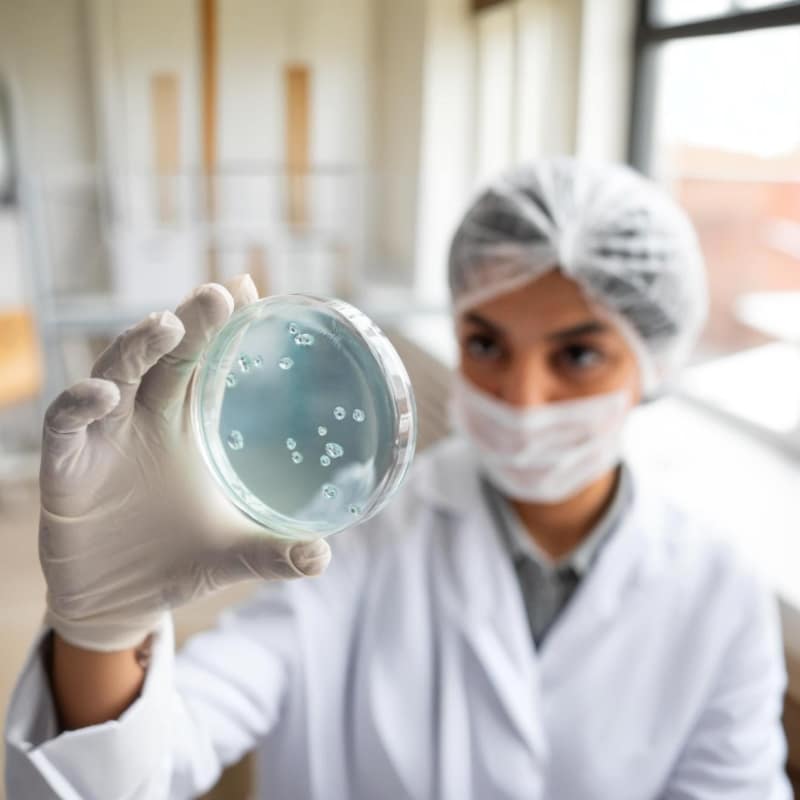
When we think of cosmetics, we often focus on color, texture, fragrance, or how a product feels on the skin. But behind every safe and effective cosmetic product lies a rigorous process of safety testing, one of the most important being cosmetic microbiological testing. This essential step ensures that beauty products are not only high-quality but also free from harmful microorganisms that can pose real risks to users.
In this guide, Certified Cosmetics walks you through what microbiological testing is, why it’s necessary, how it’s done, and what happens if a product doesn’t meet microbiological safety standards.
What Is Microbiological Testing in Cosmetics?
Cosmetic microbiological testing involves examining beauty and personal care items for harmful microorganisms such as bacteria, yeasts, and molds. Although many cosmetic products seem clean and fresh, they can still be contaminated, particularly those that contain water or natural ingredients.
These microorganisms can lead to product spoilage, diminished effectiveness, or, even worse, result in infections or allergic reactions for consumers. This testing procedure enables companies to identify these potential risks early, guaranteeing that every product available in the market is safe for everyday use.
Why Do Cosmetics Need Microbiological Testing?
Microbiological testing is essential in the cosmetic sector not only to comply with regulations but also to safeguard consumers and maintain product quality. Let’s examine the primary reasons why this testing is important.
To Keep Consumers Safe
Contaminated cosmetics may contain dangerous bacteria such as Pseudomonas aeruginosa or Staphylococcus aureus. These organisms can lead to skin infections, eye irritation, or serious allergic reactions, especially in products used near sensitive areas like the eyes or mouth.
By conducting cosmetic microbiological testing, manufacturers can detect and eliminate these contaminants before products reach the shelves.
To Make Sure Products Last
Microorganisms can break down the ingredients in a cosmetic formula, leading to unpleasant odors, changes in color or texture, and reduced effectiveness. Spoiled products can harm brand trust and increase returns or complaints.
Testing helps confirm that the product will remain safe and stable throughout its shelf life.
Because It’s Required by Law
In the majority of markets, microbiological safety is required by law and is not a choice. Regulations such as ISO 17516 and EU Regulation 1223/2009 outline the permissible limits for microorganisms in final cosmetic goods. Product recalls, penalties, or even market restrictions may follow non-compliance.
What Types of Microbiological Tests Are There?
Several testing methods are used to evaluate the microbiological safety of cosmetic products. These tests help ensure that products remain safe throughout their shelf life and meet regulatory requirements. Every cosmetic product, regardless of how natural, minimal, or niche it may be, should undergo testing, and the results should be documented as part of the product’s test report, Certificate of Analysis (CoA), or specification file.
Microbial Count Tests
Microbial count tests determine how many microorganisms are present in a cosmetic product. This is a standard requirement for all cosmetic products, no exceptions. Even water-free or powder-based products must demonstrate that microbial contamination is within acceptable limits.
These tests typically include:
- TAMC (Total Aerobic Microbial Count): Measures the total number of aerobic bacteria.
- TYMC (Total Yeast and Mold Count): Measures the total number of yeast and mold organisms.
Regulatory standards such as ISO 17516 specify maximum allowable limits for these microorganisms. If the microbial load exceeds the threshold, the product is considered unsafe and cannot be released for consumer use.
Challenge Test (Preservative Efficacy Testing)
Also known as the preservative challenge test, this method evaluates whether a cosmetic product’s preservative system can effectively prevent the growth of harmful microorganisms when exposed to intentional contamination. It involves inoculating the product with a known quantity of microbes and monitoring their survival over time.
This is a critical part of cosmetic microbiological testing, especially for products that contain water, which are more prone to microbial growth. However, there are specific exemptions to this test depending on the product type, formulation, and packaging.
For example, single-use products, anhydrous (water-free) formulations, and products packaged in sterile conditions may be exempt from challenge testing under certain criteria. These exemptions are outlined in detail in Certified Cosmetics’ resource: Which Products are Exempt from the Challenge Test?
Even when exemptions apply, a strong justification supported by documentation must be maintained as part of the product’s safety file.
When and How Are These Tests Done?
Microbiological testing isn’t just a one-time event. It should be part of the product’s lifecycle, from development to production and even reformulation.
During Product Development
Tests should be conducted before a product is launched to ensure it meets safety and stability standards. This allows companies to make adjustments before mass production begins.
After Changes in Formula or Packaging
Even small changes like replacing a raw material or switching to a new container can affect microbial stability. Retesting helps confirm that these changes haven’t introduced new contamination risks.
How the Test Works (Simple Steps)
Though each lab may vary slightly, the basic process for cosmetic microbiological testing usually includes:
- Sampling: A portion of the product is collected in sterile conditions.
- Inoculation: In some tests, known microorganisms are added to the sample.
- Incubation: Samples are stored under specific conditions to allow microbial growth.
- Evaluation: After a set period, scientists measure how many microbes remain or have grown.
These results help determine whether the product is microbiologically safe and if the preservative system is effective.
What Happens If a Product Fails the Test?
A microbiological test failure suggests that the product might not be safe for human consumption. In these situations, the brand needs to:
- Rework the product’s formulation
- Make the preservation system stronger.
- Enhance manufacturing procedures or hygiene
- Cancel or postpone the product’s debut.
In extreme circumstances, authorities can order a product recall, harming the company’s standing and financial security.
Do Natural or Organic Cosmetics Also Need Testing?
Indeed, possibly even to a greater extent. Natural or organic beauty products frequently have fewer or no artificial preservatives. This attracts numerous shoppers, but it can also increase the risk of microbial growth in these items.
Regardless of how “pure” a product claims to be, it must still participate in cosmetic microbiological testing to guarantee safety. Omitting this process endangers both consumers and the brand.
Frequently Asked Questions (FAQ): Cosmetic Microbiological Testing
Q1: What is cosmetic microbiological testing in simple terms?
It’s a safety check that looks for harmful germs like bacteria and mold in beauty products.
Q2: Can bacteria grow in sealed cosmetic containers?
Yes, especially in water-based products or those stored in warm, humid environments.
Q3: Is this testing required for every cosmetic product?
Yes. Regulations in the EU, the U.S., and many other regions require microbiological testing before products are sold.
Q4: How long does the testing process take?
Microbial count tests typically take 7–15 days. Challenge tests may take 35-50 days to complete.
Q5: Are home-made or small-batch cosmetics also required to test?
Yes. Regardless of brand size, all products intended for sale must meet microbiological safety standards.
Conclusion: Safe Start with Cosmetic Microbiological Testing
Ensuring the safety of cosmetics goes beyond mere regulatory compliance — it serves as the bedrock of consumer trust and product quality. Whether you’re creating a new formulation or expanding your product offerings, conducting microbiological testing is critical to confirm that your products are free from harmful microorganisms and remain safe throughout their shelf life.
At Certified Cosmetics, we assist brands in achieving international microbiological safety standards with precision and assurance. Our knowledgeable team and thorough testing protocols enable you to protect your formulas and launch compliant, high-quality products into the market.
Interested in discovering more about our microbiological testing services? Check out our Microbiological Testing solutions, or for additional information on cosmetic safety and compliance, visit our blog page.

